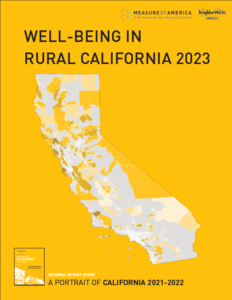 Well-Being in Rural California 2023
Well-Being in Rural California 2023
Measure of America
First published June 2023
Well-Being in Rural California 2023 paints a picture of well-being and access to opportunity across race, place, and gender in rural California today. Using the American Human Development Index (HDI), this report presents how residents in rural California are doing on three key dimensions of well-being—a long and healthy life, access to knowledge, and a decent standard of living. Broken down by race and ethnicity, by gender, and by census tract, the index shows how communities are faring relative to one another and to the state and country as a whole. The report found that stark variation exists by place and by demographic group—resulting in significant inequalities across rural areas.
Well-Being in Rural California is part of a larger project, A Portrait of California 2021–2022, which explores well-being in the state as a whole, with a special focus on housing.
The HDI is expressed on a scale from zero to ten, with ten indicating higher levels of well-being across health, education, and standard of living. Rural California as a whole scores 4.84, falling significantly below the California statewide score of 5.85. Of the two racial and ethnic groups for whom it is possible to calculate HDI scores, white residents score 5.45 and Latino residents score 3.89.
Among census tracts in rural California, HDI scores range from a low of 1.79 in Census Tract 83.01 in Fresno County to a high of 8.47 in Census Tract 6136 in San Mateo County. Most higher-scoring rural tracts can be found in the mid-coast to northern region of the state; they tend to be predominantly white and affluent. The lower-scoring tracts are predominantly inland; seven of the lowest-scoring tracts lie in the Central Valley and three lie in California’s far north.
Download Resource